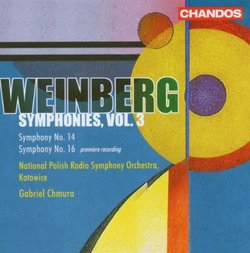| All Artists: Mieczyslaw Weinberg, Gabriel Chmura, The National Polish Symphony Orchestra in Katowice Title: Weinberg: Symphonies, Vol. 3 Members Wishing: 1 Total Copies: 0 Label: Chandos Original Release Date: 1/1/2006 Re-Release Date: 11/21/2006 Genre: Classical Styles: Historical Periods, Modern, 20th, & 21st Century, Symphonies Number of Discs: 1 SwapaCD Credits: 1 UPC: 095115133422 |
Search - Mieczyslaw Weinberg, Gabriel Chmura, The National Polish Symphony Orchestra in Katowice :: Weinberg: Symphonies, Vol. 3
 | Mieczyslaw Weinberg, Gabriel Chmura, The National Polish Symphony Orchestra in Katowice Weinberg: Symphonies, Vol. 3 Genre: Classical
|
Larger Image |
CD Details |
CD ReviewsTwo dark and dramatic symphonies Russ | Richmond, VA | 01/07/2007 (4 out of 5 stars) "Mieczyslaw Weinberg (1919-1996) is one of those composers who wrote a lot of good music, but for one reason or another has managed to remain in the realm of obscurity. Thankfully, Chandos is bringing some much needed attention to Weinberg through its ongoing efforts to record the composer's complete symphonies. I immensely enjoyed the first two volumes of this series, so I was quick to purchase this disc when it was released.
The fourteenth and sixteenth symphonies presented here, composed in 1977 and 1981 respectively, are different from the fourth and fifth symphonies presented on the preceding volumes of this series, in that Weinberg appears to have adopted (or progressed to) a more texturally sparse, and intimate, musical language. Weinberg's fourth and fifth symphonies reminded me of Shostakovich; and the two symphonies presented here remind me of Shostakovich as well. Although, these two symphonies are more readily grouped with the works of Shostakovich's later years, such as Shostakovich's fourteenth and fifteenth symphonies, whereas Weinberg's fourth and fifth symphonies bare more similarities to Shostakovich's central symphonies. Both symphonies have a tragic tone and strike me as intense works, where dissonances, angularity and harshness prevail. With that said, neither symphony is overly "difficult" from a listening standpoint. There is a certain purposefulness to these works which keeps the listener (for the most part) engaged throughout. I did note that some of the material within the slower sections was a bit bleak for my tastes, but I found the quicker sections to be consistently gripping. Symphony No. 14 opens with a lamenting largo, colored by several woodwind solos (think Shostakovich). In the symphony's frenetic second movement (Track 8), Weinberg employs a wide variety of percussion instruments, including a slapstick (again, think Shostakovich - maybe the fifteenth symphony). This movement is also notable for its heavy, and menacing, use of the low brass towards its conclusion. The final movement of the symphony (Track 10) opens with a powerful and affirmative(!) horn solo. However, harsh fortissimo orchestral accents, silencing a group of pianissimo woodwinds, bring the work to an anything but affirmative conclusion. Symphony No. 16 is cast in one movement, although the work is divided into six tracks so that the listener can navigate to the major sections of the work. Beginning with a dramatic theme in the strings over a powerful pedal tone and pounding timpani (Track 1), the dark and brooding nature of this symphony is readily apparent. The symphony soon turns aggressive (Track 2) with unison strings battling against various sections of the orchestra. Weinberg makes interesting use of the piano, especially its lower register, to create an ominous atmosphere throughout this section. Further adding to the tension in this work, is Weinberg's use of powerful cross accents (listen to the cross accents between the lower and inner string voices in Track 4 as an example). Symphony No. 16 contains alternating slow and fast sections, with the work eventually evaporating away creating a solemn conclusion. To this listener, this final section contains similarities to the ending of the first movement of Shostakovich's tenth symphony. As with the first two volumes of this series, the playing by the National Polish Radio Symphony Orchestra, Katowice is excellent and the engineering by Chandos is, as usual, great. The program notes are quite detailed and interesting, as well. In conclusion, you should get to know the works of Weinberg, especially if you are interested in the works of Shostakovich. My personal tastes lead me to state that the second volume of this series, featuring Weinberg's fourth symphony, makes a better introduction to this underrated composer, on the basis that the second volume contains a bit more variety, and that I found the musical material there to be a bit more interesting than the material here. If you have acquired the second volume, and enjoyed it, I would move to the fifth symphony (volume one), then to the symphonies presented here. My four, as opposed to a five, star rating here is solely based on the fact that I wanted to differentiate between this volume and the second. However, for those already committed to the Weinberg cause, I have no reservations about this release and I think you will find much to admire in these two symphonies. Recommended. TT: 63:42" |

 Track Listings (10) - Disc #1
Track Listings (10) - Disc #1